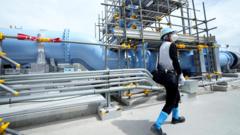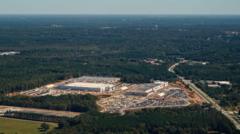In a significant policy pivot, Japan has announced it will boost its reliance on nuclear energy, fueled by increasing energy needs from sectors such as AI and semiconductors. The cabinet's newly approved energy plan, crafted by the Ministry of Economy, Trade and Industry, aims to have nuclear power contribute 20% to the energy grid by 2040—an increase from 8.5% in 2023—and notably, it removes previous intentions to reduce nuclear energy usage. This decision revives conversations around safety and public sentiment given the devastating 2011 Fukushima disaster that left lasting scars on the nation.
Japan's Nuclear Power Strategy Shift Post-Fukushima

Japan's Nuclear Power Strategy Shift Post-Fukushima
Japan plans to increase nuclear energy reliance amidst growing power demands despite Fukushima disaster shadows.
The plan is set against the backdrop of Japan's substantial dependence on energy imports, approximately 90%, and the escalating global conflicts that further complicate fuel acquisition. MP Daishiro Yamagiwa points out the need for Japan to optimize its energy sources for greater self-sufficiency and carbon reduction, stating the urgency brought about by international conflicts. Meanwhile, experts caution that ramping up nuclear energy comes with significant risks. Concerns include reliance on expensive imported uranium and the potential for catastrophic accidents, as highlighted by Professor Kenichi Oshima from Ryukoku University.
The echoes of the Fukushima disaster linger, instilling fear among citizens. Many, like Tokyo resident Yuko Maruyama, are skeptical of the plan, advocating for alternative energy sources to safeguard future generations. The waste from Fukushima continues to raise alarms, especially after Japan's controversial decision to release treated water from the site, which drew protests from neighboring countries.
Environmental groups like Greenpeace have vehemently opposed the renewed focus on nuclear energy, emphasizing the toxic legacy of radioactive waste and the ongoing dangers posed by nuclear power. While officials predict that 33 reactors are needed to meet these targets, difficulties with safety checks and community objections complicate the execution of this policy shift.
As Japan stands at this energy crossroads, it faces complex challenges balancing energy demands with the urgent need for safety and environmental responsibility, all while reflecting on the harrowing events of the past. With the momentum of the new energy plan, the nation must navigate a path towards sustainable energy while carrying the lessons of Fukushima into the future.
The echoes of the Fukushima disaster linger, instilling fear among citizens. Many, like Tokyo resident Yuko Maruyama, are skeptical of the plan, advocating for alternative energy sources to safeguard future generations. The waste from Fukushima continues to raise alarms, especially after Japan's controversial decision to release treated water from the site, which drew protests from neighboring countries.
Environmental groups like Greenpeace have vehemently opposed the renewed focus on nuclear energy, emphasizing the toxic legacy of radioactive waste and the ongoing dangers posed by nuclear power. While officials predict that 33 reactors are needed to meet these targets, difficulties with safety checks and community objections complicate the execution of this policy shift.
As Japan stands at this energy crossroads, it faces complex challenges balancing energy demands with the urgent need for safety and environmental responsibility, all while reflecting on the harrowing events of the past. With the momentum of the new energy plan, the nation must navigate a path towards sustainable energy while carrying the lessons of Fukushima into the future.




















